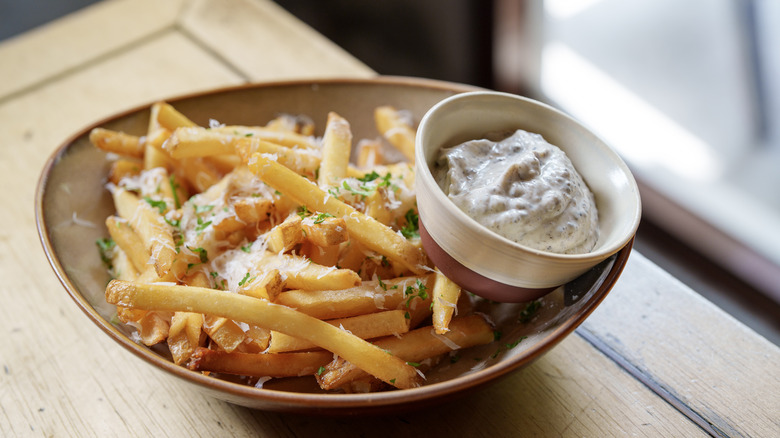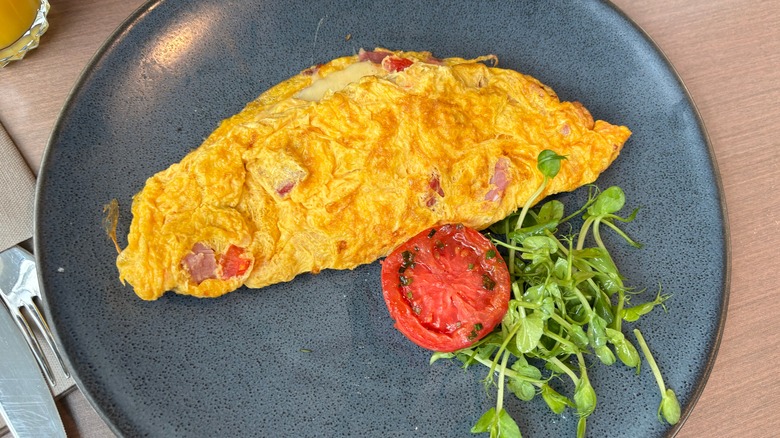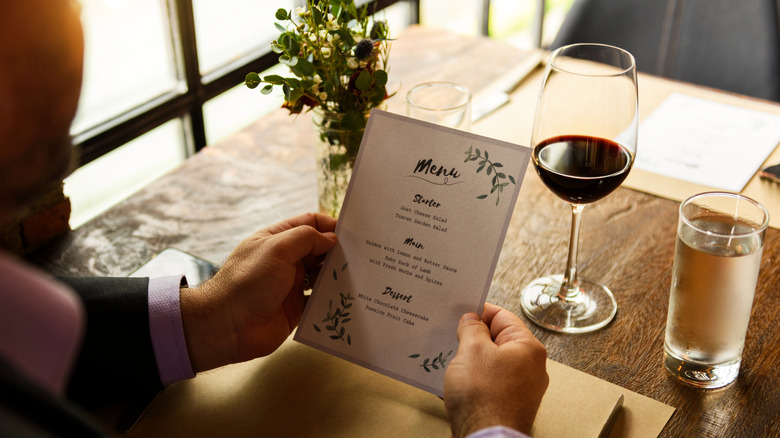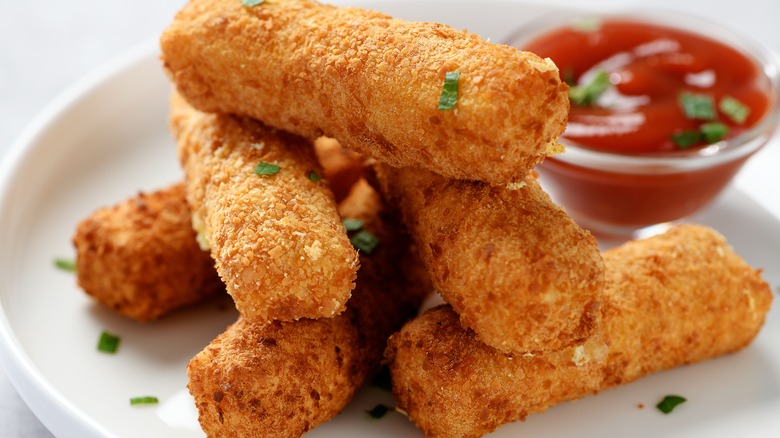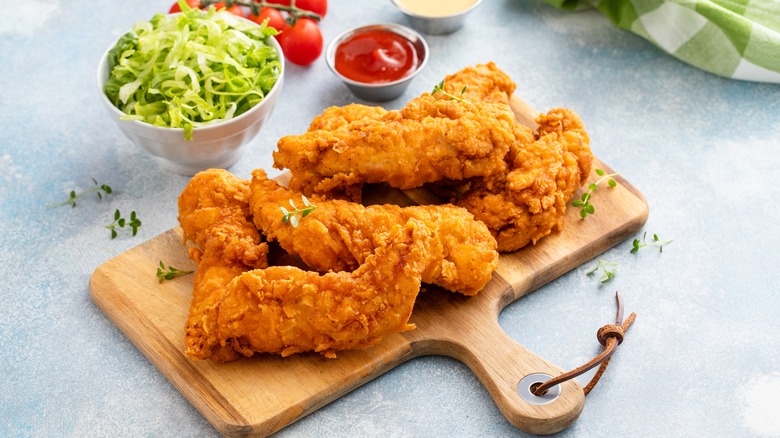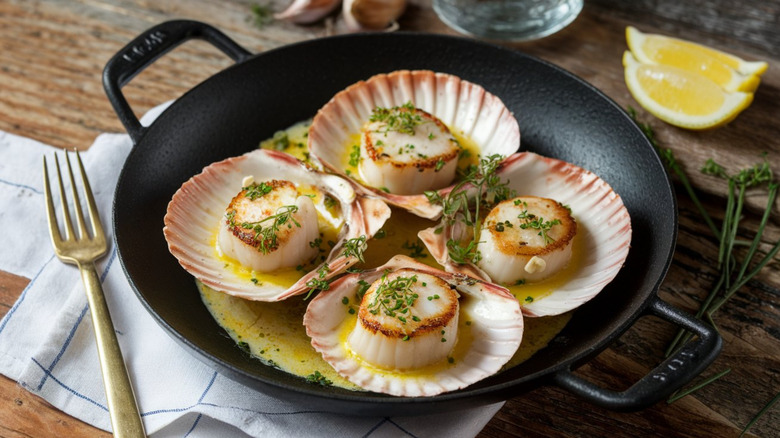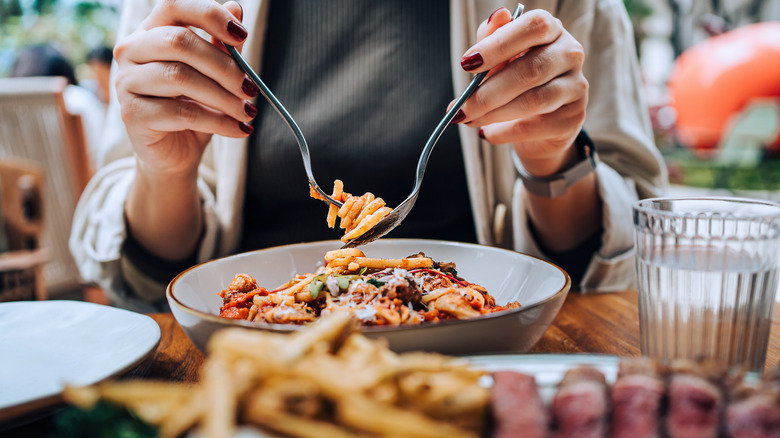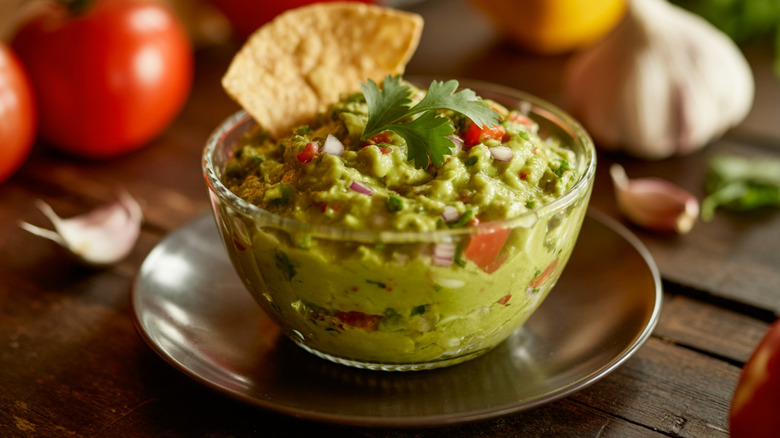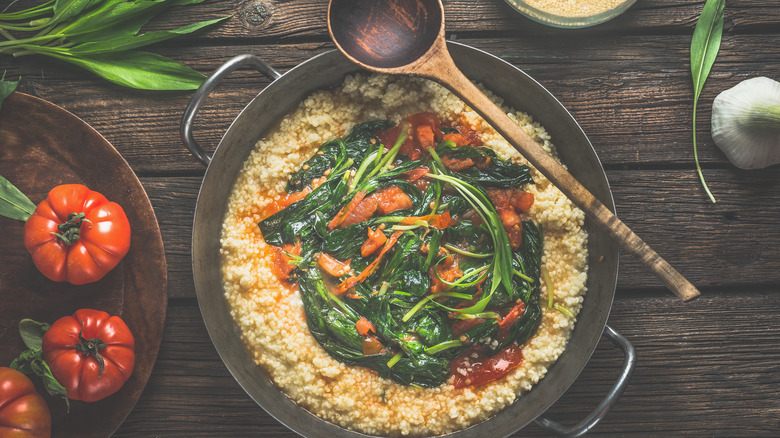The Most Overpriced Restaurant Menu Items Are A Total Waste Of Money
Heading out for a meal has become a commonplace activity. Cooking at home is often seen as somewhat boring, and unless you're a decent cook, home cooking simply doesn't match the bursting flavors or intriguing ingredients that you'll find in a restaurant setting. From fast food to luxury menus, the marketplace of cuisines offers something for everyone to get excited about. Unfortunately, eating out at a restaurant also brings with it some financial woes that modern consumers will often want to avoid. It's no secret that eating takeout or sitting down for a prepared meal rather than cooking on your own enjoys a precipitous financial markup. All services you pay for cost more to the consumer than they do for the provider, that's just the nature of business. But the restaurant scene is a particularly expensive one, and many items you'll find on the menu can see double, triple, or more in the difference between a restaurant's cost and the prices it prints on menus.
Not all dishes and menu additions exhibit the same exorbitant divide in pricing, though. Some are especially costly to the consumer, and perhaps stand as purchases you should always look to avoid. Numerous menu staples across restaurant genres are just so simple, making them an easy option to incorporate into your own cooking. Whether it's pasta dishes or a selection of sides that can be realistically recreated in your own kitchen for a sliver of the expense, these menu items will set your budget back significantly.
Truffle fries
Truffle fries are meant to be the stuff of luxury. Truffles are a decadent treat that can elevate even the most simplistic ingredients. They're often delicately draped over pasta dishes and other simple yet refined meals. Truffles have also become a type of topping for notably less fine dining-type menu items. One of the main culprits in this trend toward adding luxury features to pedestrian meals is the truffle fries. Gold has been added to some foods as a means to create a talking point while amplifying the price, and truffles offer a similar outcome. The experience is meant to feel like a taste of the good life, but in truth, truffle fries actually tend to contain no genuine truffle at all.
Instead of a finishing touch that's been meticulously hunted by the trained noses of truffle hogs and dogs, menu items that aren't already found in luxury settings — and particularly fries —tend to utilize synthetic truffle oils to provide the flavor addition. Namely, the lab-created 2,4-Dithiapentane does all the heavy lifting in most instances of the truffle fry. Unless you're purchasing a truffle fry dish that actually features genuine truffle shavings heaped over the top, skipping this selection is likely wise. Many instances of the creation feature a dousing of truffle oil spread over the top, and since these oils tend to use synthetic chemicals rather than the real deal, you're paying top dollar for a forgery when ordering the dish.
Omelets
The egg is a staple in cuisines found throughout the world. Eggs are a key element in all kinds of cooking, and are used as an ingredient for flavor, binding, and more in some cases. Elsewhere on menus, eggs stand out as the shining star in some selections. The recent surge in egg prices aside, this ingredient tends to be found cheaply and in great abundance. However, that low cost doesn't translate into the pricing found on printed menu pages. Eggs feature huge markups when placed front and center on the plate. Leading the charge here is the omelet. These layered egg concoctions tend to utilize simple mixes of ingredients and are quick and easy to cook. So long as the egg isn't burnt or otherwise mishandled in the cooking process, customers rarely have negative things to say about an omelet that comes out of the kitchen. These dishes feature interchangeable internal "parts," with most only requiring slightly different additions either at the beginning or near the end of the cooking process, and all to a single pan or griddle top segment.
In an omelet you'll buy at a breakfast joint, the ingredients are diced up vegetables and meats, meaning each addition to the plate costs just cents for the restaurant to source. Markups for omelets can be as high as 566%, making that breakfast out at a restaurant a painfully pricy choice. Making your own breakfast is always going to be the better financial choice whenever that decision is available.
Wine, especially by the glass
Wine markups are extreme, routinely going for 300% over the wholesale price, and sometimes even more. Bottles are costly, but wine by the glass is even more capital-extracting. Drinks are frequently some of the best sellers for restaurants in terms of profit, and wine stands among the front of the pack. This is likely because opening a wine bottle is its own experience. Each bottle tells its own story, with the terroir infused into each sip. There's a notable difference between pinot grigios sourced in France, Australia, or Chile, and more subtle changes in the taste and overall drinking experience when considering regions or even vineyards within the same country. What each individual drinker prefers will vary, and so the wine bottle has become a selling point that works very hard to make the liquid held within feel important and elegant. Even cheap bottles lean into the experience side of things.
Unfortunately for restaurant drinkers, there's no good way around the price hike. Some restaurants will allow you to bring your own bottle, but will almost certainly charge a corkage fee that offsets the savings you might stand to enjoy by going this route. I have personally eaten at a steakhouse and then walked across the street to a liquor store and found the exact same bottle for a fraction of the price listed for a wine on the establishment's menu. This markup is expected and well-known, but the temptation to splash the cash on an expensive drink with dinner is too great for most diners.
Mozzarella sticks
Where to start with one of the easiest appetizer dishes ever conceived? Mozzarella sticks are made with breading ingredients (flour, bread crumbs, and eggs) and stick-shaped mozzarella slices. Anyone can make them at home, and if you're doing it yourself it will cost a few bucks to make a heaping helping of the stuff. Instead, you can pay upwards of $10 for a plate offering just a few mozzarella sticks when ordering at a restaurant, while wholesale mozzarella costs as little as $2 per pound. This dish is absolutely delectable, certainly, but the markup for such a simple list of ingredients is an affront to sensibility.
In all seriousness, mozzarella sticks are just so easy to make that anyone who might consider themselves a lover of the appetizer menu item can and should just make a stock of them. Mozzarella sticks can be purchased from grocery stores as a frozen bagged item, and if you're making them at home, you'll also use the freezer to help in the creation process. After you've breaded your cheese, you need to place the sticks in the freezer for around an hour to allow them to bind fully. If you're making a big batch, just transfer the ones you don't want to cook and eat right away to an airtight container and fire them back into the freezer for later.
Chicken tenders
Chicken tenders are a super-simple dish. Breaded, sliced chicken is coated in whatever spices a restaurant or home chef might like to deploy for flavoring, and then they're tossed into frying oil to impart a golden crisp. Chicken tenders are incredibly easy to make, and they're among the numerous things you'll find on restaurant menus that can be bought for much cheaper in the frozen section of the grocery store. Some restaurants might, as a result, simply buy frozen tenders and cook them up as their own creations, saving on the labor costs, too.
Chicken tenders feature a typical markup of around 185%, meaning you can shave a huge price margin off the cost by just cooking them at home. Whether you go the whole hog and slice up chicken to bread and spice yourself or just opt for premade tenders is up to you, but either way the choice to eat these menu staples at home is a seriously cost saving choice. It's worth noting, though, that if you do commit to the entire preparation process, you can cut your tenders to much juicier, thicker standards. This will yield not just a price reduction, but also a much more satisfying end result in many cases.
Shellfish dishes of all sorts
All kinds of seafood dishes come at premium prices when ordering in a restaurant. Depending on your location, price hikes can be moderate or severe (distance from the nearest ocean or river certainly plays a role, as do cost of living expenses in certain cities). But the reality is that in most places, wholesale fish prices aren't excessive. This is particularly true for shellfish. Restaurants often get crab, lobster, and other shellfish like scallops and mussels for similar prices to other protein staples like chicken or beef. Even so, seafood is generally considered a luxury, something that other food items — categorically — don't tend to enjoy. Restaurant goers don't tend to have a problem in paying heightened rates for a plate of shrimp while scoffing at elevated costs for something like chicken tenders (even though shrimp are magnificently abundant).
The luxury element of even the simplest seafood dishes translate into increased costs for consumers. To add insult to injury, numerous staples on a restaurant's menu in this arena are painfully easy and quick to make. Scallops and octopus legs, for instance, are seared on a pan for a matter of seconds with little advanced preparation necessary.
Pasta dishes
Pasta can be found in a kaleidoscope of styles. There are so many pasta dishes out there, utilizing more shapes and types of the food than you can probably imagine. Pastas and noodles more broadly have been a staple of global cooking for centuries, and for good reason. To make noodles of many varieties, all you need is flour, water, and salt, with the occasional egg brought into the mix. Pasta can be a nuisance to make for those new to the practice, but that hasn't stopped countless people from trying their hand at homemade pasta creation (especially during the pandemic years and at other trying times throughout history). Even if you're not someone prepared to dedicate some additional time to preparing pasta totally from scratch, store bought noodles, shells, or sheets are cost effective options.
What isn't cost effective is purchasing this menu item at a restaurant. Pasta is cheap to make and similarly inexpensive to source premade. This means that restaurants are significantly upcharging customers for pastas that cost pennies on the dollar to create, sometimes as much as 300%. Italian restaurants are particularly notorious in this regard. Italian is a cuisine that people across the country truly love, and so it might be difficult to give up visits to your favorite establishment. However, knowing that you're being taken for a ride when ordering veal parm or a chicken marsala is important to keep in mind so that you can save these purchases for special occasions and cook your pasta at home during other times.
Guacamole (and many other items featuring avocados)
It's certainly true that avocados aren't exactly cheap these days. Avocados have rocketed into the public consciousness, and they can be found as an ingredient littered across menus and prominently displayed in grocery stores. The grocery price might suggest that avocado-based dishes aren't all that unreasonable, but there's a big difference between the price you might pay for an avocado at a big retailer and the wholesale price that business customers can find. Avocados were imported in 2024 to an average price per pound of $1.43. Mexico is by far the largest supplier of avocados to the U.S., adding another wrinkle to the equation with tariff concerns and other trade questions continuing to circulate around the U.S. economy.
Whatever the price you might pay at your local grocery store, the bulk purchasing power of a restaurant that specifically features avocado elements will help reduce the business' costs here. The result is an end product of guacamole, avocado toast, sushi items, or avocado-enhanced salads that prey on the idea that this ingredient is expensive and premium. In reality, avocados aren't particularly off limits to consumers, so a heightened price tag isn't justified. Moreover, many restaurants actually serve up premade guacamole instead of making it in house, reducing their costs once again while positioning the menu item as something worthy of reverence and high expense.
Coffee
Coffee is one of the most dynamic commodities on the planet. Coffee beans are grown in hot regions all across the globe, and the industry has capitalized on the regionality of these sources to entice buyers to invest in products that feature all sorts of unique provenance, growing factors, and other characteristics. Coffee is both a basic drink and one that can be prepared with immense nuance that elevates it to a premium experience that comes with a particularly steep price hike.
Not only will a cup of coffee out and about set you back a tidy sum, naturally, it's one of the most marked up menu items you'll find anywhere in the restaurant game. Coffee can be marked up by as much as 900% — you're reading that right: That's nine times what it costs a restaurant or coffee shop to source the ingredients! Even at their most conservative estimates, if you brewed a cup of coffee for yourself every morning instead of buying one on your way to work, you'd save at least a few hundred dollars. For those who enjoy a cup of Joe that isn't just poured from pot to cup (or 'black'), the savings can easily skyrocket into the thousands. What's more, when purchasing beans for yourself to prepare at home, you'll have even greater control over the particular experience you get to enjoy. If you're a fan of those high altitude beans grown in Ethiopia, focus on bags that come from farms there, but of course, always invest in free trade options that commit to rooting out the exploitation of farmers that has long dominated the coffee growing space.
Risotto
The expense of risotto comes in the production, not the ingredients. Risotto is built on a bed of rice, albeit a specific type of rice. Even so, you'll find risotto rice at your local grocery store for a reasonable price with just a bit of searching. Risotto requires a slow and semi-labor intensive cooking process to keep the rice from becoming an inedible slop. This is where the cost comes into the picture. Much like some other dishes that use cheap and minimal ingredient lists like omelets, mozzarella sticks, and more, risotto is flavored with stock and rounded out with small vegetable and other additions. The shopping list to produce a fabulous risotto at home is surprisingly affordable and short.
Even with the process requiring you to stand over the pot at times, the task of creating a risotto is actually quite straightforward. The main ingredient really is just patience. Therefore, paying through the nose for a decadent risotto dish at a restaurant really isn't necessary. Cut up a few onions and mushrooms (and don't forget the parmesan and cream) and take a stab at it yourself. The results are likely to surprise you, and your wallet will sing your praises, too.

